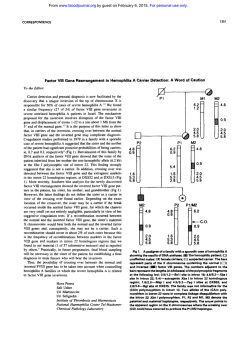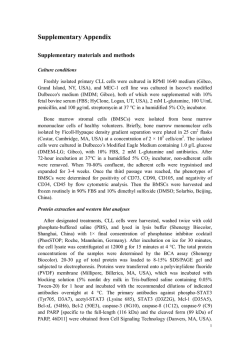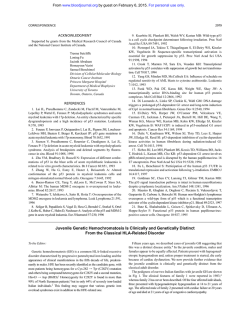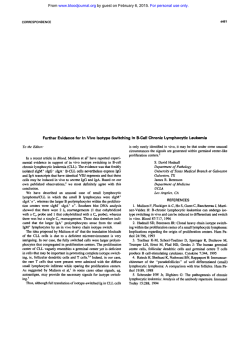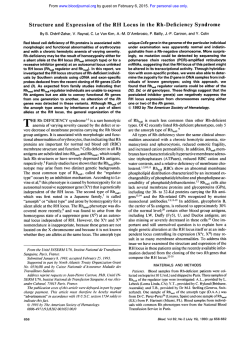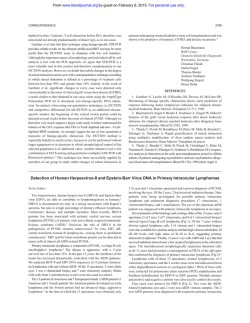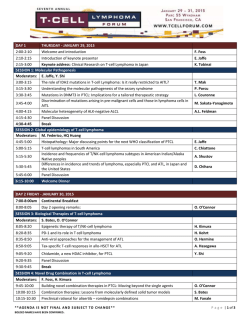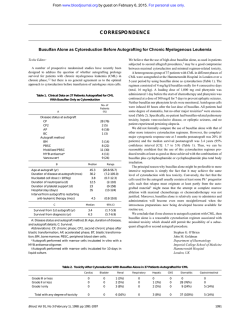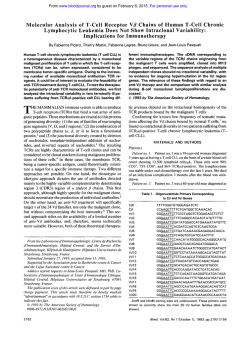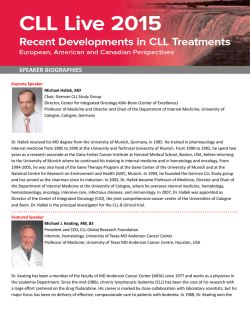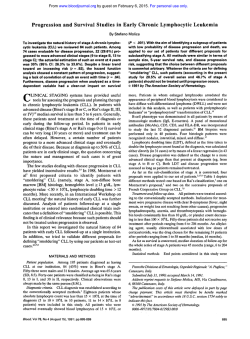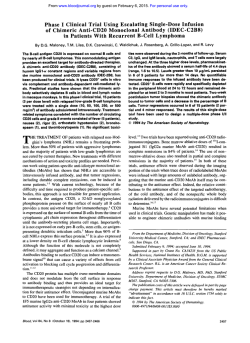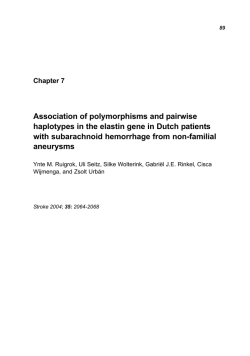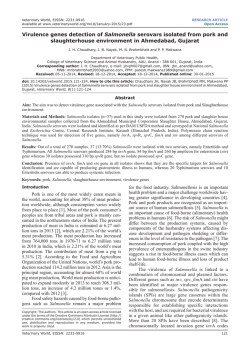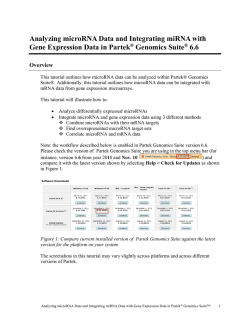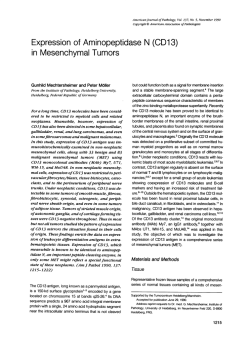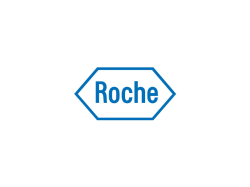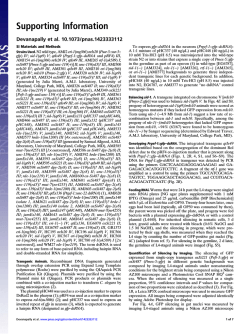
Differential Usage of an Ig Heavy Chain Variable Region
From www.bloodjournal.org by guest on February 6, 2015. For personal use only. Differential Usage of an Ig Heavy Chain Variable Region Gene by Human B-Cell Tumors By Freda K. Stevenson, Myfanwy B. Spellerberg, Joanna Treasure, Caroline J. Chapman, Leslie E. Silberstein, Terry J. Hamblin, and David B. Jones A monoclonal anti-idiotypic antibody has been raised that recognizes Igs with heavy chains encoded by a member of the V,4 family, the V,4-21 gene segment. The idiotope (Id) is detectable on a high percentage of early B cells in fetal spleen, and is expressed by certain autoantibodies, particularly cold-reactive anti-red blood cell antibodies. Therefore, it was of interest to investigate usage of this V, gene by neoplastic B cells; 81 chronic lymphocytic leukemias (CLLs) involving CD5+ B cells and 6 2 B-cell lymphomas of varying histologic type have been analyzed. The Id was expressed by only 3 of 81 (3.7%)of the CLLs, indicating a relatively low usage by these tumors. In contrast, the Id was expressed by 9 of 62 (14.5%) of the lymphomas across a range of histologic types, indicating a differential use of the V,4-21 gene among B-cell neoplasms. For three of the Id-positive lymphomas, each of a different histologic class, the nucleotide sequence of the tumor-derived V, gene was determined; the V,4-21 gene was identified, as expected. The sequence from the CLL was identical to the germline sequence, and the marginal zone lymphoma showed only 3 nucleotide changes, 2 of which gave rise to amino acid substitutions. In contrast, the sequence from the follicular lymphoma showed 29 nucleotide changes giving rise to 1 4 amino acid substitutions, which were scattered among the CDR and FW regions. 0 1993 by The American Society of Hematology. D quency of V, family use was similar to that reported for normal blood lymphocytes, indicating no selective bias at this level, although there was a suggestion of nonrandom use of individual members of the V,4 family.' During our studies of the idiotypic determinants expressed by cells of B-cell lymphomas, we raised a monoclonal anti-idiotype (anti-Id), 9G4, that recognizes a conformation-dependent Id encoded by the heavy chain of a member of the V,4 family, the V,4-2 1 gene.'-'' This deduction was made after profiling the reactivity of a large panel of sequenced Igs with the anti-Id"'," and has been confirmed by others.I2 An assessment of the involvement of this gene in a panel of human monoclonal Igs showed a highly restricted usage, with 0 of 55 IgGs and 1 of 19 IgM paraproteins being Id-positive; interestingly, the positive IgM was an autoantibody directed against the Ii carbohydrate antigen on the surface of red blood cells (RBCs), a so-called cold agglutinin,'and we have found subsequently that 48 of48 autoantibodies of this specificity express the Id and, in 8 cases studied by sequence analysis, use the V,4-21 This degree of restriction of a V, gene for an antibody specificity is highly unusual, and implies some structural requirement for the framework sequence encoded by the gene for antigen recognition. However, although the V,4-2 I gene appears mandatory for cold agglutinins, it can also be used by other antibodies, and has been reported to encode an IgG autoanti-DNA antibody." Further investigation of Id expression showed that a significant proportion (-6%) of B cells in the fetal spleen were positive,16 and that the Id was present on CD5' B cells in cord blood." In fact, 24% of Epstein-Barr virus (EBV)transformed B-cell clones established from CD5+ cord blood lymphocytes expressed the Id.I7 However, this figure does not necessarily reflect the frequency of Id-positive cells in the untransformed population, because there could be differences in the responses of B cells to EBV. Sequence analysis of 2 of 2 of these Id-positive EBV clones has confirmed usage of the V,4-2 1 gene (Dean et al, submitted for publication). Taken together, the evidence suggested that the V,4-2 1 gene was active early in normal B-cell maturation, was associated with CD5 positivity, and was used by neoplastic B cells involved in secreting autoanti-RBC antibodies. It was therefore of interest to investigate the various URING MATURATION of a normal B cell, selection and recombination ofa particular V, gene with other genetic elements occurs, giving rise to a functional V,-D-J, unit. This selection is from among the six known V, families in the germline (V, I to V,6), with family sizes varying from I (v,6) to more than 30 (v,3) of an estimated total of 100 to 200 V, gene segments.lS2In fact, the frequency of use of the individual V, families by normal adult blood lymphocytes appears to correlate roughly with estimates of family size based on Northern blotting or in situ hybridizati~n.~.~ With regard to neoplastic B cells, there is evidence for deviation from this random use of V, families by certain tumors; the most studied group of these is chronic lymphocytic leukemia (CLL), in which biased expression of genes from the V,5 and V,6 families, accompanied by an underrepresentation of V,1 and V,2, has been reported.s.6 The neoplastic cell typical of CLL is usually CD5+ and normal or neoplastic B cells expressing this marker apparently derive from a separate lineage that, in both human and mouse, appears to be associated with synthesis of autoantibodies.' Considerably less is known of V, use by other Bcell tumors, although V, restriction could give rise to crossreactive idiotypes that might have a diagnostic or monitoring potential.' However, in a recent survey of 36 cases of follicular lymphoma, it was found that the fre- From the Molecular Immunology Group, Tenovus Laboratory, and the Department of Pathology, Southampton University Hospitals, Southampton. UK;and the Department of Pathology and Laboratory Medicine, Hospital of the University of Pennsylvania, Philadelphia, PA. Submitted November 17, 1992; accepted February 15, 1993. Supported by Tenovus, the Cancer Research Campaign, the Wessex Medical Trust, UK, and by a collaborative grant from NATO. Address reprint requests to Freda K. Stevenson, DPhil, Molecular Immunology Group, Southampton University Hospitals, Tenovus Laboratory, Tremona Rd, Southampton SO9 4XY. UK. The publication costs of this article were defiayed in part by page charge payment. This article must therefore be hereby marked "advertisement" in accordance with 18 U.S.C. section 1734 solely to indicate this fact. 0 1993 by The American Society of Hematology. 0006-49 7l/93/820I-0008$3.00/0 224 Blood, VOI 82, NO 1 (July 1). 1993: PP 224-230 From www.bloodjournal.org by guest on February 6, 2015. For personal use only. VH GENE USAGE BY HUMAN B-CELL TUMORS categories of B-cell tumors for Id expression, anticipating that it would be found to be preferentially expressed by those tumor cells that are thought t o arise from the early CD5 lineage, ie, CLL. + MATERIALS AND METHODS Cell suspension analysis. Blood was obtained from patients with CLL and from two patients with lymphoma; lymphocytes were separated using Ficoll-Hypaque. Cells were then suspended in warm medium (RPMI 1640, HEPES buffered) containing fetal calf serum (FCS; lo%), streptomycin (0.1 mg/mL), and penicillin (60 pg/mL) and washed twice. Cell surface antigens were analyzed in the FACS-SCAN (Becton Dickinson Lab Systems, Mountain View, CA) by indirect immunofluorescence using monoclonal anti-Ig reagents as described" and anti-CD5 (OKTl; ATCC, Rockville, MD), with fluorescein isothiocyanate (FIX)-labeled sheep antimouse IgG (Sigma Chemical Co, Poole, Dorset, UK) for detection. In one case of lymphoma (JJ), frozen cells were cytocentrifugedand analyzed by the sensitive single-stage alkaline phosphatase-antialkaline phosphatase (APAAP) technique, with sheep antimouse Ig as second bridging antibody followed by complexes of AP with its mouse antibody.16The rat anti-idiotypic antibody, 9G4, which detects the VH4-21-associated Id, has been It is of the IgG2a subclass, and was used with a control subclass-matched rat antibody; detecting antibody was FITC-sheep antimouse IgG selected for cross-reactivitywith rat IgG. Tissue section analysis. Frozen tissue sections obtained from reactive lymph node, or from lymph node, spleen, and lung from patients with lymphoma were used to assess expression of Id. Cases of B-cell lymphoma were obtained from the frozen tissue files ofthe Department of Pathology, University ofsouthampton, and the original histologic diagnosis, made according to the Keil classification," was confirmed by independent review. Cryostat sections ( 5 pm) were air-dried at room temperature and stored at -70°C until required. Immediately before staining, the sections were fixed in acetone for 10 minutes and then stained by an indirect immunoperoxidase technique using HRP-rabbit antimouse IgG or HRP-rabbit antirat IgG, followed by development of reaction product by diaminobenzidine tetrahydr~chloride.'~ A diagnostic monoclonal antibody (MoAb) panel, containing antibodies against CD37, CD19, CD22, CD5, and CDlO, in conjunction with antibodies against Ig heavy and light chains, was used to confirm the presence of a B-cell tumor and allowed identification of areas of tumor involvement. Morphologicallyidentified tumor cells were considered positive if a clear membrane immunoperoxidase reaction product could be seen in the frozen section. Patients. Patients with a clinical diagnosis of CLL were identified from the routine immunology laboratory; those with a white blood cell count (WBC) ofgreater than 10 X 109/Land with tumor cells expressing the CD5 antigen were included in the study. Three patients with Id-positive tumor cells were selected for nucleotide sequence analysis; each of these represented a distinct category of B-cell neoplasia. The first patient, KR (a 69-year-old woman) was a typical long-standing case of CLL, having a lymphocytosis (8 X 109/L)comprising small K-positivemonomorphic lymphocytes. The second patient was a 63-year-old man, JJ, who presented in 1986 with a lymphocytosis and an enlarged spleen that was removed surgically.The histologic diagnosis was of a lymphocytic lymphoma with greater than 90% tumor cells in the involved spleen and bone marrow. However, a more recent assessment ofthe histologic appearance of the spleen has led to an assignment to the category of marginal zone lymphoma. The blood lymphocyte count was 7.5 X 109/L,of which the majorityi>95%) were X-positive tumor cells. These cells were stored frozen in liquid nitrogen for further analysis. The third patient, PS (a 43-year-old woman), pre- 225 sented in 1987 and had a lymph node removed surgically;the histologic diagnosis was of follicular lymphoma involving cells of centroblastic and centrocytic morphology. The patient also had a lymphocytosis (3.7 X 109/L)consisting of greater than 90% K-positive tumor cells; treatment with several courses of chemotherapy failed to control disease and tumor cells in the blood were at 4.5 X 109/Lwhen collected for the study. Establishment of cell line from JJ. Active EBV was harvested from the marmoset cell line B95/8 and filtered (0.45 pm) before use. Blood lymphocytes from patient JJ were suspended in B95/8 culture fluid at 2 X IO6 cells/mL. After incubation for 1 hour, cells were centrifuged, resuspended in medium, and plated at 5 X IO5 cells/well in 200 pL medium in a 96-well plate. After a minimum of 4 days, cells received fresh medium and were monitored for growth before transfer. When in flasks, supernatant was taken for assay of IgM and Id by enzyme-linked immunosorbent assay (ELISA) as described,16and cells were examined for clonality by staining for Id using the single-stage APAAP technique. Cloning and sequencing of the productively rearranged VH gene. For the V, of the EBV line established from JJ, the method of cloning and sequencing has been described in detail." For patients KR and PS, a more rapid method of direct sequencing from cDNA was used. Total RNA was isolated from -5 X IO6 tumor cells (>95% of the blood lymphocyte population) using RNAzol B (Cinna Biotecxlaboratories Inc, Houston, TX) and was reverse transcribed with Moloney murine leukemia virus reverse transcriptase and a Not-l-d(T),, primer (Pharmacia LKB, Uppsala, Sweden). One-twentieth of the cDNA was amplified by polymerase chain reaction (PCR) using an oligonucleotide primer specific for the VH4 heavy chain leader (5'-ATGAAACACCTGTGGTTCTT)and a C p primer (5'-CGAGGGGGAAAAGGGTTGG).12Amplified products were electrophoresed through a 1.5% agarose gel and purified using Geneclean I1 (Bio 101 Inc, La Jolla, CA). Purified DNA (100 ng) was sequenced directly by the dideoxy chain termination method with T7 DNA polymerase (Pharmacia) and 100 ng of the relevant PCR primer. PCR amplification and sequencing was performed three times. RESULTS Phenotypic analysis of blood cells from patients with CLL. Samples of blood lymphocytes from patients with a diagnosis of CLL and WBC ofgreater than 10 X 109/L were analyzed in the FACS-SCAN. All expressed CD5, and those that were also clearly positive for surface Ig were selected for further study, giving a total of 8 1. The surface Ig was identified as IgMK (43) or IgMh (38), and ofthese, 2 IgMK and 1 IgMX also expressed the V,4-2 1-associated Id. The overall percentage of positivity ofthe Ig-expressingtumor cell populations in CLL was therefore 3.7%(Table 1). Expression of Id in normal lymphoid tissue. The fact that the Id is expressed by 3% of B cells in normal lymph nodes has been described,16 and the detailed distribution of those cells in a typical follicle of a normal lymph node is shown in Fig I . Staining with anti-CD22, a pan-B-cell antigen (Fig lA), shows a high density of B cells in the mantle zone, with a mixed population containing some B cells in the follicle center. Figure 1B then shows a similar distribution for the Id-positive cells; there is a clear subpopulation of Id-positive B cells in the mantle zone, comprising a small percentage of the total B-cell population. However, Id-positive cells are not confined to the mantle zone, because there are also some scattered cells visible within the folliclecenter. - From www.bloodjournal.org by guest on February 6, 2015. For personal use only. STEVENSON ET AL 226 Table 1. Expression of Id by 6-Cell Tumors No. of No. of Cases Positive Cases CLL Lymphocytic lymphoma Marginal zone lymphoma 81 9 1 3 Follicle center cell lymphoma: Follicular, low grade Intermediateand high grade 18 28 2 6 1' Tumor Category Lymphoma of mucosa-associated lymphoid tissue 0 1 5 This single positive case showed morphologic transformation to a high-grade tumor. E.ypre.ssion qf Id in R-cell ljwplioma. The incidence of Id positivity among lymphomas of various histologic type is also shown in Table I. In each case, the Id was expressed by the morphologically identifiable tumor cell population. and there were 9 of 62 clear positives (14.5%). which is significantly higher than that for CLL (. 1 > P > .05 by xzanalysis). Although numbers in each histologic category are too small to detect any significant differences, there is an indication of a low incidence in lymphocytic lymphoma (0 of 9 positive). consistent with the similarity of this neoplasm in morphology and behavior to CLL." Expression of CD5 was heterogeneous among the lymphocytic lymphomas, with 6 of 8 being positive ( 1 case was not evaluable). An example of the pattern of staining in the follicle center of a lymph node infiltrated with Id-positive tumor is shown in Fig 2. Again, the pan-B-cell marker CD22 has been used to stain the total B-cell population (Fig 2A). and the positive cells (marked with arrows). identifiable by darkly stained surface membranes. are clearly visible among a background of T cells, with the morphology of the stained population being strongly suggestive of tumor cells. This feature is also seen in Fig 2B using the anti-Id antibody that stains the large pleiomorphic tumor cells (marked with arrows) in a pattern similar to that with anti-CD22, suggesting that most ofthe B cells are neoplastic. The phenotypic analysis of the Id-positive cases, including those from the CLL group (Table 2), indicates that there was a mixture of K and X light chain types and that all identifiable heavy chains were p. In one case of A-expressing highgrade lymphoma. technical reasons prevented allocation of the heavy chain class. All the cases of Id-positive CLL were CD5'. but the Id-positive lymphomas were all C D Y (Table 2). Ana1jsi.s of liimor cells . f h n patients KR, JJ, and PS. The phenotypic profiles of the tumor cells from the three patients available for nucleotide sequence analysis, KR, JJ, and PS, are included in Table 2 and are indicated by an asterisk. For patient KR (CLL), the blood lymphocytes included 73% of IgMr-positive cells, all of which were positive for both Id and CD5: the majority of the remaining lymphocytes (22%)were T cells. For JJ (marginal zone lymphoma), the blood lymphocytes that were used for genetic analysis had a profile similar to that of the splenic tumor cells, with the majority (>95%) of cells expressing Id-positive IgMX. but no CD5, and few detectable T cells. After transformation with EBV. the same IgMld profile was maintained in greater than 95% of the cells in the line, and transformed cells secreted IgMX that was all idiotypic by ELISA.I6 consistent with a clonal population. For patient PS (follicular lymphoma), the Ig phenotype of tumor cells in the lymph node sections was IgMK and C D Y (Table 2); again, the neoplastic blood lymphocytes used for genetic analysis were of the same phenotype being greater than 90% positive for Id-positive IgMK. Moleciilar analwis qf e.ypre.s.sed l/, genes qf KR, PS, and JJ. The nucleotide sequence of the V, region of the IgM from patient KR indicates that it is identical to the germline V,4-2 1 gene sequence (Fig 3). The V, sequence of JJ is also derived from the V,4-2 1 germline gene, and there are only three mutations. However, as shown in Fig 4, two of the Fig 1. Expression of 964 Id by normal 6 cells in a reactive lymph node. (A) 6-cell population stained with anti-CD22. (6) Id-positive cell population stained with anti-Id (964). Positively stained cells are indicated by arrows. Original magnification X 450. From www.bloodjournal.org by guest on February 6, 2015. For personal use only. 227 V, GENE USAGE BY HUMAN E-CELL TUMORS three mutations givc rise to amino acid substitutions. ic. a glycine to aspartic acid in C D R I and a lysine to arginine in IW3. Interestingly. the same two substitutionsarc found in the PS V, (Fig 4). and the gly to asp substitution via the same nucleotide change has been observed in four other Table 2. Phenotypic Analysis of Id-Positive Cases lg Tumor Category CLL Marginal zone lymphoma Follicle center cell lymphoma: Follicular, low grade Intermediate and high grade Lymphoma of mucosa-associated lymphoid tissue Tissue Expression CD5 Blood Blood Blood' Blood,' spleen lgMX lgMx lgMh IgMDh + Lymph node,' blood Lymphnode Lymph node Lymph node Lymph node Lymphnode Lymphnode 1gMx - lgMX lgMX lgMx lgMx lgMX - Lung + + - At - lgMX - Nucleotide sequence analysis of V. genes was performed on the tissues indicated. t The heavy chain was not identified in this case. lgMs derived from V,4-2 I . all of which had cold agglutinin activity: however. it is not mandatory for such sp~cificity.'~ The V, sequence of PS is also similar to the V,4-2 I germline gene. but in this case thew is only 90.0a homology with 29 nucleotidc ditrerenccs. giving rise to 14 amino acid substitutions. Among the recently updated analysis of the VH4 family.'" the sequence of PS lies within the VS8 group. which also includcs V,4-2 I . However, homology with the other members of the group is less than 90%and the VH4-2 I gene is the closest match. The D segments of KR and JJ are both long (Fig 4) and JH6is used in each case. In fact. K R has a strctch of 26 nucleotides homologous to the D X P 4 germline gene and JJ hasa stretch of 23 nucleotides homologous to the D L R 3 germline gene.'' with flanking sequences showing shorter sequence homologies to two other D segments. In contrast. the D segment of PS is a short sequence with a stretch of 7 nucleotides homologous to the D M ? germline gene." In all thrcc cases. thcre are probable N-termind additions. DISCUSSION Anti-idiotypic antibodies have been used for more than 20 years to idcntify common structures in the variable regions of Ig moleculcs.'' Thc advcnt of monoclonal anti-Ids Fig 2. Expressionof 964 Id by neoplastic B cells in a lymph node from a patient with follicular lymphoma. Note that follicle mantle zones seen in normal lymph node have been ablated. (A) E-cell population stained with anti-CD22 MoAb (original magnification X 250). (B) Id-positive cell population stained with anti-Id (9G4); arrows indicate positive membrane staining of clusters of neoplastic cells (original magnification X 250). For comparison, see the negative lymphocytes in the follicle center of Fig 1E. (C) Id-positive cell population stained with anti-Id (9G4) at higher magnification (original magnification X 400). with small reactive lymphocytes appearing to be negative. From www.bloodjournal.org by guest on February 6, 2015. For personal use only. 228 STEVENSON ET AL CDRl 1 I VH4.21 (GL) CAGGTGCAGCTACAGCAGTGGGGCGCAGGACTGTTGPAGCCTTCGGAGACCCTGTCCCTCACCTGCGCTGTCTATGGTGGGTCC TTCAGTGGTTACTACTGGAGC TGWTCCGCCAGCCCCCAGGGAAGGGGCTG w( (1gH) JJ (IgM) -------A------------PS (1gH) --------A-----A-----------------A-----------------T--A----------------------------------C-A-----------A------------T-------A--------- .............................. .................................................................................... ..................... .................................................................................... .............................. CDR2 I I VH4.21 (GL) GAGTGGATTGGG GAAATCAATCATAGTGGPAGCACCPACTACAACCCGTCCCTCPAGAGT CGAGTCACCATATCAGTAWCACGTCCAAGAACCAGTTCTCCCT~GCTGAGCTCTGTGACCGCCGCGGACACG KR (IgH) ---------------____-____________________-------JJ (Ign) ----------_-____________________________-----------------------------------------------------G------------------A--------pS (IgH) A&-------------------C------C-G-------------------------- ------G----C---A-T-------------CG------------CG-T---C----C----G------------ ........................................................................... _----------_ -_-----_--__ D SEGMENT VH4.21 (GL) GCTGTGTATTACTGTGCGAGA GG ..................... JJ (IgH) (IgH) pS (IgH) ---C----------------- w( 1 I GTAGGCTGGTATTACGATTTTTGGAGTGGTTATTCGGTCTCCGAC TACTACTACATGGACGTCTGGGGCMAGGCACCACGGTCACCGTCTCCTCA JH6 AATGGAACCTCTGGCGAT TTTGACTACTGGGGCCAGGWCCTGGTCACCGTCTCCTCA _--_---_--___________ AGCTCCGCCCCACCTATTGTGGTGGTGACTGCTATTCCATTGACCGCT~CCGGGC TACTACGGTATGGACGTCTGGGGCCAACCCAeCACGCTCACCGTCTCCTCA JH6 JH4 Fig 3. Nucleotide sequence comparison of the V,,4-21 germline gene segment and the VMgene segments expressed in three patients with B-cell tumors. Patient KR, CLL; patient JJ, marginal zone lymphoma; patient PS,follicular lymphoma. allowed more precise localization of the sequences involved in Id expression, and such reagents have proved useful for investigations of the clonal Igs characteristic of B-cell lymphomas,' and of the oligoclonal autoantibodies synthesized in autoimmune diseases such as systemic lupus erythematosus (SLE).23The monoclonal anti-idiotypic antibody 9G4 that we raised in 1986' has proved particularly useful because it recognizes an Id that is expressed by Igs with heavy chains encoded by a defined VHgene, V,4-2 1, a member of the V,4 family. The Id has been reported to be expressed by 13 of 13 Igs that use this gene,l33I4and we have since found it to be present on a further 29 of 30 sequenced Igs with heavy chains encoded by the V,4-2 I gene (unpublished observations). In contrast, it is not expressed by other sequenced Igs encoded by different members of the vH4 family, or by Igs from other V, families.",12 Another interesting point is that the Id is expressed by autoantibodies that are specific for the I/i carbohydrate antigen on the RBC surface, the so-called cold agglutinins, and it appears that these autoantibodies are all encoded by the VH4-21 gene.Lo.'2,'4This degree of restriction of a V, gene for a particular antibody is highly unusual; however, the V,4-2 I gene is not confined to anti-RBC antibodies, be- CDRl n cause it has been found also to encode autoanti-DNA antibodies." Studies on fetal spleen showed that the Id was expressed early in development, being identifiable on -6% of B cells at 20 weeks of gestation.I6 The id was also detected on cord blood lymphocytes, in which it appeared to be preferentially expressed by CD5+ B cells.'7 This finding ofexpression ofan Id, known to be associated with both cold agglutinins and anti-DNA autoantibodies, by immature CD5+ B cells led us to anticipate that the Id would be present on CD5' neoplastic cells found in CLL, thereby supporting the proposed link between this normal cell population and the cells found in CLL.24In fact, it is known that a significant proportion of such tumors synthesize autoantibodies, particularly rheumatoid factor.25The proposal that CLL could represent the neoplastic counterpart of immature B cells found in fetal spleen has been supported by the finding of common highfrequency cross-reactive Ids,26some of which have been located to usage of certain V-genes, particularly V,IIIb.27 Assymetric usage of V, genes has been also reported for CLL, with increased involvement of v H 4 , vH5, and VH6.' However, the finding in this report is that expression of the Id associated with a member of the vH4 family, V,4-2 1, which cDR3 CDRP I I I VH4-21 (GL) QVQLQQWGAGLLKPSETLSLTCAVYGGSFSGYYWS MIRQPPGKGLEWIG EINHSGSTNYNPSLKS RVTISVDTSKNQFSLKLSSVTAADTAVYYCAR KR (IgH) ____________________________ VGWYYDFWSGYSVSD YYYHDV JH6 JJ (IgH) _ _ _ _ _ _ _ _ _ _ _ _ _ _ _ _ _ _ _ _ _ _ _ _ _ _--D---__ ---------------R---------------SWPIVWTAIPLTAQPG YYGHDV JH6 PS (IgM) _________________-_-________ --D---N ----S-----T------R-TA---------A--I----T----R-T-L------L----NGTU;D FDY JH4 _______ ______________ ________________ ________________________________ ______________ ________________ Fig 4. Deduced amino acid sequence comparison of the VM4-21germline gene segment and the V. gene segments expressed in three patients with B-cell tumors. Patient KR, CLL; patient JJ, marginal zone lymphoma; patient PS, follicular lymphoma. From www.bloodjournal.org by guest on February 6, 2015. For personal use only. VH GENE USAGE BY HUMAN B-CELL TUMORS is expressed by -6% of fetal B cells, is found on only 3 of 8 1 (3.7%) cases of CD5' CLL. This indicates a consistency between the use of the V,4-21 gene by early B cells and its incidence in CLL. However, usage in CLL is low in comparison with other V, genes such as the 5 l p l V, 1 gene, which is associated with the G6 idiotope.26For G6, although expression in the fetal spleen (6.9%) is comparable with our results for the VH4-21-associated Id, expression by cases of CLL is high (20%).26Loss of Id by mutation is an unlikely explanation for this relatively low level of expression because Vgenes in CLL tend to be unmutated"; also, the Id appears to tolerate quite extensive mutations without loss (Pascual et all0 and unpublished observations). In contrast to CLL, the V,4-2 1 gene is used by neoplastic B cells that secrete IgM with cold agglutinin activity,I0,l2and these tumors represent a significant proportion (13 of 105, ie, 12%) of the IgM-secreting neoplasms known as Waldenstrom's macr~globulinaemia.~~ Because the tumor cells tend not to be in the blood, there is less information on their CD5 status; however, in our preliminary studies using double staining for Id and CD5, we have found that the majority of cases (7 of 8) do express CD5 (unpublished observations). The relatively high incidence of use of the VH4-21gene in this group of tumors could indicate that they develop from a normal, possibly CD5+, B cell that is distinct from that which gives rise to CLL. Our findings that the gene appears to be switched on after certain common infections such as EBV29asuggest that those postinfective IgMId-secreting cells could represent the population that undergoes neoplastic transformation. The frequency of Ig class switching events among this normal B-cell population is not yet clear; certainly the V,4-2 I gene can be found in IgG,'o,'5but a search of our myeloma IgG protein panel found 0 of 55 positive for indicating a low use of the gene in plasma cell tumors. With regard to expression of the 9G4-associated Id in normal lymphoid tissue, we have shown already that it has a wide distribution.16 Within the lymph node there is a clear population of Id-positive B cells in the mantle zone, but there is also expression by some of the cells in the germinal center. This distribution is consistent with the specificity of the antibody for an Id that is effectively a V-region subgroup determi~~ant,~' and it appears to hold for the 9G4 Id that has a restricted specificity within the V,4 family. The finding of 9 of 62 Id-positive cases among the lymphomas indicates that the V,4-2 1 gene is used at about the same frequency as in Waldenstrom's macroglobulinemia, and more commonly than in CLL (. 1 > P > .05 by x2 analysis). Previously, we found the Id-positive population of normal lymph node to represent 3.2% 2.4% of the B cellsI6; this would suggest that the incidence of 14.5%in B-cell lymphomas reflects a preferential use of the V,4-2 1 gene. It will be ofinterest to expand the investigation ofthe various histologic types of lymphoma to see if there is any heterogeneity of expression among the groups. In a previous study of lowgrade follicular lymphoma, usage of V, families by tumor cells was comparable to that by normal B cells; however, use of individual members of the V,4 family appeared asymetric, with 3 of 8 of the tumors of the 1 1 to 14 member V,4 family being assigned to V,4-2 1.' To verify the association between Id expression and usage - * 229 of the V,4-21 gene, we investigated the nucleotide sequences of randomly chosen B-cell tumors from the panel. Tumor-derived material was available from three patients, one a typical CLL and two having lymphomas of different histologic categories. For this particular V, gene, we have the advantage first, that it has a sequence that is quite distinct from other members of the V,4 family3' and second, that it has a very low degree of polymorphism, which allows recognition of mutations from the germline gene.32In fact, in a recent study of a random series of I 1 Id-positive clones established from six patients with infectious mononucleosis, we have found the V,4-2 1 to be in germline configuration and to be identical in nucleotide The sequences obtained from the three tumors were closely related to the V,4-21 germline gene, which has a characteristic sequence particularly in FWl . In fact, that from patient KR was typical of the pattern found in C D Y CLL in being unmutated from germline." Little is known concerning V,-gene usage in marginal zone lymphoma, but it was interesting to note a very low level of mutations in this CD5- tumor. In contrast, the sequence of the V, gene from the follicular lymphoma PS showed 29 mutations, ofwhich 18 were replacements. This result is consistent with previous findings in follicular lymphoma, and may reflect the fact that normal B cells undergo hypermutation in the follicle center.33In fact, in a recent report of a case of follicular lymphoma involving the V,4-2 1 gene, a similar number of mutations from germline (23) was found.34However, if an analysis of the pattern of mutations in the two cases is made, there are differences, in that the changes in patient PS do not show a high rep1acement:silent ratio in the complementarity determining regions (CDRs) that may result from antigen selection. For patient PS, the analysis of mutations was performed in the same way. To assess the incidence of replacement and silent mutations, each change was assumed to have occurred independently and was designated as R or S and located in the CDRs or in framework regions ( F W R S ) .The ~ ~ majority ofthe mutations (23) are located in FWregions, particularly FWR3, and the numbers of replacement and silent mutations in the FWRs ( 1 3R and 10s) and in the CDRs (5R and 1S) are not sufficiently different from those expected from a random distribution and composition (FWRs: 14R and 8s; CDRs: 4R and 3s) to indicate a role for antigen selection. This finding contrasts with the published case in which there were 23 mutations, with a concentration of replacement mutations ( 1 1) in the CDRs compared with 4 expected.34Clearly, more sequences of the V-genes of tumor cells are needed and the relatively nonpolymorphic V,4-2 1 gene is ideal for investigating this crucial point. At present, it is difficult to assess the role of chemotherapy in inducing mutations, because the patient in the previously reported and in the current study had both received chemotherapy. It will be of interest in the future to analyze V-gene sequences from patients at presentation. Even if chemotherapy is not a perturbing factor, it is possible that the situation in the lymph node is complicated in that the hypermutation mechanism may be activated in a B cell, but, after a neoplastic event, the tumor cell may or may not be influenced by antigen. From www.bloodjournal.org by guest on February 6, 2015. For personal use only. STEVENSON ET AL 230 REFERENCES 1. Berman JE, Mellis SJ, Pollock R, Smith CL, Suh H, Heinke B, Kowal C, Sirti U, Chess L, Cantor CR, Alt F W :Content and organization of the human Ig V, locus: Definition of three new V, families and linkage to the Ig C, locus. EMBO J 7:727, 1988 2. Schroeder HW, Hillson JL, Perlmutter RM: Structure and evolution of mammalian V, families. Int Immunol 2:41, 1989 3. Logtenberg T, Young FM, van Es J, Gmelig-Meyling FHJ, Berman JE, Alt F W Frequency of V,-gene utilization in human EBV-transformed B-cell lines: The most J,-proximal V, segment encodes autoantibodies. J Autoimmun 2:203, 1989 (suppl) 4. Guigou V, Cuisnier A, Tonnelle C, Moinier D, Fougereau M, Fumoux F Human immunoglobulin V, and V, repertoire revealed by in situ hybridization. Mol Immunol 27:935, 1990 5. Logtenberg T, Schutte MEM, Inghirami G, Berman JE, Gemlig-Meyling FHJ, lnsel RA, Knowles DM, Alt FW:Immunoglobulin V, gene expression in human B cell lines and tumors. Biased V, gene expression in chronic lymphocytic leukemia. Int Immunol 1:362, 1989 6. Mayer R, Logtenberg T, Strauchen J, Dimitriu-Bona A, Mayer L, Mechanic S, Chiorazzi N, Borche L, Dighiero G , Mannheimer-Lory A, Diamond B, Alt F, Bona C: CD5 and immunoglobulin V gene expression in B-cell lymphomas and chronic lymphocytic leukemia. Blood 75: 15 18, I990 7. Hayakawa K, Hardy RR: Normal, autoimmune and malignant CD5+ B cells: The Ly-l lineage? Ann Rev Immunol 6:197, 1988 8. Stevenson FK, Wrightham M, Glennie MJ, Jones DB, Cattan AR, Feizi T, Hamblin TJ, Stevenson GT: Antibodies to shared idiotypes as agents for analysis and therapy for human B cell tumors. Blood 68:430, 1986 9. Bahler D, Campbell MJ, Hart S, Miller RA, Levy S, Levy R: Ig V, gene expression among human follicular lymphomas. Blood 78:1561, 1991 10. Pascual V, Victor K, Lelsz D, Spellerberg MB, Hamblin TJ, Thompson KM, Randen I, Natvig J, Capra JD, Stevenson FK: Nucleotide sequence analysis ofthe V regions oftwo IgM cold agglutinins. Evidence that the V,4-2 1 gene segment is responsible for the major cross-reactive idiotype. J lmmunol 146:4385, 1991 1 1. Thompson KM, Sutherland J, Barden G, Melamed M, Randen I, Natvig JB, Pascual V, Capra JD, Stevenson FK: Human monoclonal antibodies against blood group antigens preferentially express a V,4-2 1 variable region gene-associated epitope. Scand J Immunol 34:509, 1991 12. Silberstein LE, Jefferies LC, Goldman J, Friedman D, Moore JS, Nowell PC, Roelcke D, Pruzanski W, Roudier J, Silverman G: Variable region gene analysis ofpathologic human autoantibodies to the related i and I red blood cell antigens. Blood 78:2372, 1991 13. Stevenson FK, Spellerberg MB, Jefferies LC, Goldman J, Hamblin TJ, Pascual V, Capra JD, Silberstein LE: Monoclonal gammopathies and autoimmunity, in Topics in Ageing Research in Europe. Monoclonal Gammopathies 111, Vol 14. Leiden, The Netherlands, Eurage, 199 I , p 33 14. Pascual V, Victor K, Spellerberg M, Hamblin TJ, Stevenson FK, Capra JD: V, restriction among human cold agglutinins: The VH4-21 gene segment is required to encode anti-I and anti-i specificities. J Immunol 149:2337, 1991 15. van Es JH, Gmelig Meyling FHJ, van de Akker WRM, Aanstoot H, Derksen RHWM, Logtenberg T: Somatic mutation in the variable regions of a human anti-double stranded DNA autoantibody suggest a role for antigen in the induction of systemic lupus erythematosus. J Exp Med 173:46 1, 1991 16. Stevenson FK, Smith GJ, North J, Hamblin TJ, Glennie MJ: Identification of normal B-cell counterparts of neoplastic cells which secrete cold agglutinins of anti4 and anti-i specificity. Br J Haematol 72:9, 1989 17. Mageed RA, MacKenzie LE, Stevenson FK, Yuksel B, Shokri F, Maziak BR, Jefferis R, Lydyard PM: Selective expression of a V,IV subfamily of immunoglobulin genes in human CD5’ B lymphocytes from cord blood. J Exp Med 174: 109, I99 1 18. Lennert K, Feller AC: Histopathology of Non-Hodgkin’s Lymphomas (ed 2). Berlin, Germany, Springer-Verlag, 1990 19. Harvey JE, Jones DB: Distribution of LCA protein subspecies and the cellular adhesion molecules LFA-I, ICAM-I and p150,95 within human foetal thymus. Immunology 70:203, 1990 20. Weng N-P, Snyder JG, Yu-Lee L, Marcus DM: Polymorphism of human immunoglobulin V,4 germ-line genes. Eur J Imtsuoka H, Kurosawa Y: Organization of human immunoglobulin heavy chain diversity gene loci. EMBO J 7:4141, 1988 22. Williams RC, Kunkel HG, Capra JD: Antigenic specificities related to the cold agglutinin activity of gamma M globulins. Science 161:379, 1968 23. lsenberg DA, Staines NA: DNA antibody idiotypes. An analysis of their role in health and disease. J Autoimmun 3:339, 1990 24. Boumsell L, Coppin H, Pham D, Raynal B, Lemerle J, Dausset J, Bernard A: An antigen shared by human T cell subsets and B cell chronic lymphocytic leukemic cells: Distribution on normal and malignant cells. J Exp Med I52:229, 1988 25. Casali P, Prabhakar BS, Notkins AL: Characterization of multireactive autoantibodies and identification of LEU- 1+B lymphocytes as cells making antibodies binding multiple self and exogenous molecules. Int Rev Immunol 3:17, 1988 26. Kipps TJ, Robbins BA, Carson DA: Uniform high frequency expression of autoantibody-associated crossreactive idiotypes in the primary B cell follicles of human fetal spleen. J Exp Med 17 I: 189, 1990 27. Kasaian M, Ikematsu H, Casali P: CD5+ B lymphocytes. Proc SOCExp Biol Med 197:226, 1991 28. Kuppers R, Game A. Rajewsky K: B cells of chronic lymphatic leukemia express V genes in unmutated form. Leuk Res 15:487, 1991 29. Crisp D, Pruzanski W: B-cell neoplasms with homogeneous cold-reacting antibodies (cold agglutinins). Am J Med 72:915, 1982 29a. Chapman CJ, Spellerburg MB, Smith GA, Carter SJ, Hamblin TJ, Stevenson FK: Autoanti-red cell antibodies synthesized by patients with infectious mononucleosis utilize the V,4-2 1 gene segment. J Immunol (in press) 30. Axelrod 0,Silverman GJ, Dev V, Kyle R, Carson DA, Kipps TJ: ldiotypic cross-reactivity of immunoglobulins expressed in Waldenstrom’s macroglobulinemia, chronic lymphocytic leukemia, and mantle zone lymphocytes of secondary B-cell follicles. Blood 77: 1484, 199 1 31. Lee KH. Matsuda F, Kinashi T, Kodaira M, Honjo T: A novel family of variable region genes of the human immunoglobulin heavy chain. J Mol Biol 195:761, 1987 32. Sanz I, Kelly P, Williams C. Scholl S, Tucker P, Capra J D The smaller human V, gene families display remarkably little polymorphism. EMBO J 8:3741, 1989 33. Levy R, Levy S, Cleary ML. Carroll W, Kon S, Bird J, Sklar J: Somatic mutation in human B-cell tumors. lmmunol Rev 96:43, 1987 34. Bahler DW, Levy R: Clonal evolution of a follicular lymphoma: Evidence for antigen selection. Proc Natl Acad Sci USA 896770, 1992 From www.bloodjournal.org by guest on February 6, 2015. For personal use only. 1993 82: 224-230 Differential usage of an Ig heavy chain variable region gene by human B- cell tumors FK Stevenson, MB Spellerberg, J Treasure, CJ Chapman, LE Silberstein, TJ Hamblin and DB Jones Updated information and services can be found at: http://www.bloodjournal.org/content/82/1/224.full.html Articles on similar topics can be found in the following Blood collections Information about reproducing this article in parts or in its entirety may be found online at: http://www.bloodjournal.org/site/misc/rights.xhtml#repub_requests Information about ordering reprints may be found online at: http://www.bloodjournal.org/site/misc/rights.xhtml#reprints Information about subscriptions and ASH membership may be found online at: http://www.bloodjournal.org/site/subscriptions/index.xhtml Blood (print ISSN 0006-4971, online ISSN 1528-0020), is published weekly by the American Society of Hematology, 2021 L St, NW, Suite 900, Washington DC 20036. Copyright 2011 by The American Society of Hematology; all rights reserved.
© Copyright 2025
